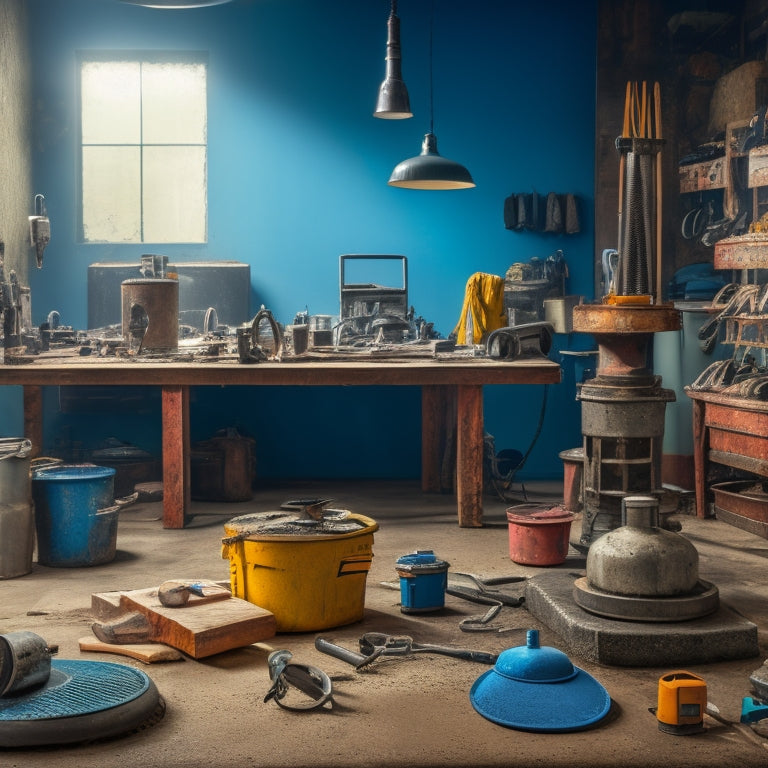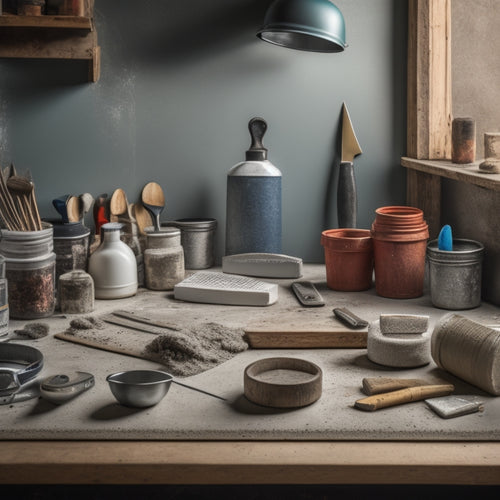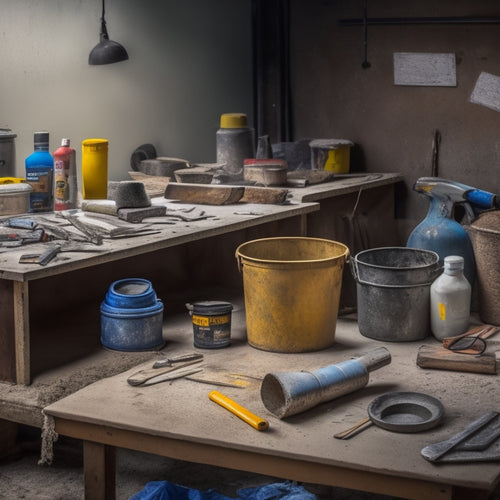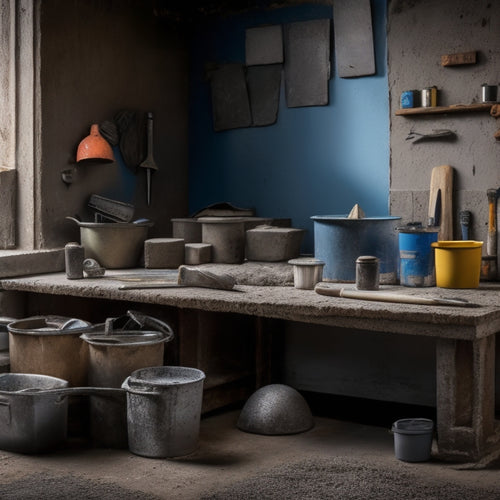
What Tools Do You Need to Grind Concrete Floors
Share
You'll need a range of specialized tools to grind a concrete floor, including walk-behind grinders for large areas, handheld grinders for edges and tight spaces, and edger tools for precision work. Diamond polishing pads, available in different materials and bond hardness, will also be vital for achieving the desired finish. Abrasives, such as coarse, medium, and fine grits, will help you progress from removing old coatings to refining the surface. Don't forget dust control and vacuum systems, as well as personal protective equipment like respirators, safety glasses, and gloves, to guarantee a safe and healthy working environment. As you prepare to tackle your concrete floor grinding project, understanding the nuances of each tool and technique will be essential to achieving a successful outcome.
Key Takeaways
• Different types of grinders, including walk-behind and handheld, are suited for specific tasks and concrete conditions.
• A planned grit sequence, ranging from coarse to fine, ensures a smooth and even finish.
• Diamond polishing pads, chosen based on concrete type and desired finish, are essential for achieving a high-gloss finish.
• Edger tools, such as walk-behind and handheld, are necessary for grinding in tight spaces and corners.
• Safety essentials, including personal protective equipment and vacuum systems, are crucial for preventing respiratory hazards and equipment damage.
Essential Grinders for Concrete Floors
You'll need a reliable grinder to effectively remove old coatings, smooth out rough surfaces, and prepare your concrete floor for a new finish.
For efficient concrete surface preparation, it's essential to choose the right grinder for the job. There are various types of grinders available, each suited for specific tasks and concrete conditions. For instance, walk-behind grinders are ideal for large areas, while handheld grinders are better suited for edges, corners, and tight spaces.
When it comes to grinding technique variations, you'll want to take into account the type of grinder and its intended use. For example, a planetary grinder is perfect for aggressive grinding and removing thick coatings, while a rotary grinder is better for finer grinding and polishing.
Additionally, the type of abrasive used will also impact the grinding technique. By selecting the right grinder and abrasive, you'll be able to achieve the best results and guarantee a smooth, even finish for your concrete floor.
Diamond Polishing Pads Explained
As you move forward with diamond polishing pads, you'll need to contemplate the key factors that determine which pad is right for your project.
You'll need to think about the type of concrete you're working with, the desired finish, and the equipment you're using.
Pad Selection Criteria
When selecting diamond polishing pads for concrete floor grinding, it's important to keep in mind the aggregate hardness, floor finish, and equipment type to guarantee peak performance and results.
You'll need to choose the right pad materials, which can be metal-bonded, resin-bonded, or hybrid. Metal-bonded pads are ideal for aggressive grinding and are often used for removing thick coatings or uneven surfaces. Resin-bonded pads are better suited for honing and polishing, as they provide a higher gloss finish. Hybrid pads offer a balance between the two.
You'll also need to take into account the pad shapes, which can be round, square, or rectangular. Round pads are great for edge work and getting into tight spaces, while square pads are better for open areas and providing a more aggressive cut. Rectangular pads offer a compromise between the two.
Additionally, think about the pad's bond hardness, which affects its ability to effectively grind and polish the concrete. By keeping these factors in mind, you'll be able to select the right diamond polishing pads for your specific concrete floor grinding project, ensuring the best possible results.
Grit Sequence Importance
Selecting the right diamond polishing pads is only half the battle; a well-planned grit sequence is essential to achieving a high-gloss finish, removing scratches, and minimizing labor costs. You need to understand the different grit types and their applications to create an effective sequence.
Here's a general outline to follow:
-
Coarse grits (16-30): Used for removing heavy scratches, unevenness, and old coatings. These grits are aggressive and should be used with caution to avoid over-grinding.
-
Medium grits (40-80): Designed for refining the surface, removing minor scratches, and preparing for higher grits. These grits are less aggressive than coarse grits but still effective.
-
Fine grits (100-200): Used for polishing and refining the surface, removing minor scratches, and achieving a high-gloss finish. These grits are less aggressive and more precise.
- Extra-fine grits (300-3000): Used for final polishing, removing minor imperfections, and achieving a mirror-like finish. These grits are very fine and require careful handling.
Edger Tools for Tight Spaces
You'll often need edger tools specifically designed for tight spaces to achieve precise control and maneuverability in areas like stairwells, corners, and along baseboards.
These edger tools come in various types, including walk-behind edgers, handheld edgers, and oscillating edgers. Walk-behind edgers are ideal for larger areas, while handheld edgers provide more precision and control in tight spaces. Oscillating edgers, on the other hand, offer flexibility and adaptability in confined areas.
When working in tight spaces, it's vital to employ specific techniques to guarantee effective results. One technique is to maintain a consistent pace, moving the edger in a steady, controlled motion.
Another technique is to use a 'push-pull' motion, applying gentle pressure while pushing the edger forward and pulling it backward. This motion helps maintain control and prevents the edger from getting stuck.
Additionally, using a dust containment system or vacuum attachment can help minimize dust and debris in tight spaces.
Handheld Grinders for Small Jobs
For smaller concrete floor grinding tasks or touch-ups, handheld grinders prove an ideal solution, offering the necessary power and precision to tackle tight areas and intricate details. With their compact design and lightweight construction, you can easily maneuver these grinders into tight spaces, allowing you to focus on specific areas that require attention.
Here are some key benefits of handheld grinders for small jobs:
-
Portability: Handheld grinders are easy to transport and can be taken to any area of the floor, making them perfect for spot repairs and touch-ups.
-
Versatility: These grinders can be used for a variety of grinding techniques, including removing old coatings, smoothing out rough surfaces, and polishing concrete.
-
Precision: Handheld grinders provide the precision you need to work in tight areas, such as around edges, corners, and stairs.
- Cost-effectiveness: Handheld grinders are often more affordable than larger grinders, making them a cost-effective solution for small jobs.
When using a handheld grinder, make sure to follow proper grinding techniques and safety protocols to achieve ideal results.
With the right tool and technique, you'll be able to tackle even the smallest concrete floor grinding tasks with ease.
Walk-Behind Grinders for Large Floors
When tackling large concrete floors, you'll want to take into account the floor's size and your grinder's capabilities to guarantee efficient grinding.
You'll also need to reflect on the weight of your walk-behind grinder, as it can impact your ability to maneuver and control the machine.
Floor Size Considerations
Larger floors require walk-behind grinders with higher horsepower and heavier construction to efficiently grind and polish the entire surface.
When working on large floors, you'll need a grinder that can handle the square footage without compromising on performance. The floor shape and room layout also play an essential role in determining the right grinder for the job. For instance, a floor with multiple corners or obstructions may require a grinder with a more maneuverable design.
Here are some key considerations for large floor grinding:
-
Floor size: Measure the floor area to determine the required grinder size and horsepower.
-
Room layout: Consider the room's dimensions, doorways, and any obstructions that may affect grinder movement.
-
Floor shape: Account for irregular floor shapes, such as L-shapes or U-shapes, that may require specialized grinding techniques.
- Grinding pattern: Plan your grinding pattern in advance to guarantee efficient coverage of the entire floor area.
Grinder Weight Matters
How much weight can you realistically handle when operating a walk-behind grinder on a large concrete floor, and what are the implications of grinder weight on your performance and safety? A heavier grinder can be more challenging to maneuver, especially on uneven floors, which can compromise your stability and increase the risk of accidents. On the other hand, a grinder that's too light might lack the necessary power to effectively grind the concrete.
| Grinder Weight | Grinder Stability | Operator Fatigue |
|---|---|---|
| Light (<200 lbs) | Lower | Higher |
| Medium (200-400 lbs) | Moderate | Moderate |
| Heavy (>400 lbs) | Higher | Lower |
When choosing a walk-behind grinder, consider the weight distribution and its impact on grinder stability. A well-balanced grinder with a lower center of gravity will be more stable and easier to control, reducing the risk of accidents and operator fatigue. Additionally, a grinder with a heavier weight can provide more aggressive grinding, but it may require more effort to maneuver, which can lead to operator fatigue. By considering the implications of grinder weight, you can select the right tool for your large concrete floor grinding project.
Efficient Work Pattern
By establishing a systematic work pattern, you can optimize your grinding efficiency and coverage on large concrete floors, guaranteeing a uniform finish and minimizing rework. This efficient workflow is vital when working with walk-behind grinders, as it enables you to manage your time effectively and complete the job within the allocated timeframe.
To achieve an efficient work pattern, follow these steps:
-
Divide the floor into sections: Break down the large floor into smaller, manageable sections to maintain focus and track your progress.
-
Identify the most efficient grinding direction: Determine the direction that allows you to grind the most floor area with the least amount of effort, taking into account the floor's layout and any obstacles.
-
Grind in a consistent pattern: Maintain a consistent grinding pattern, such as in straight lines or in a serpentine motion, to guarantee uniform coverage and prevent missed spots.
- Overlap your passes: Overlap your grinding passes by about 50% to ensure thorough coverage and prevent visible lines or patterns.
Dust Control and Vacuum Systems
When you're grinding concrete floors, you're generating massive amounts of dust that must be controlled and removed efficiently to prevent respiratory hazards, equipment damage, and environmental contamination.
Effective dust control and vacuum systems are essential to guarantee a safe and healthy working environment. To achieve ideal dust collection, you'll need a vacuum system specifically designed for concrete grinding.
These systems typically feature a high CFM (cubic feet per minute) rating, which enables them to capture the large volumes of dust generated during the grinding process.
Additionally, look for a system with advanced air filtration, such as HEPA (High Efficiency Particulate Air) filters, which can capture 99.97% of particles as small as 0.3 microns. This guarantees that the air is clean and free from hazardous particles, protecting both you and your equipment.
Safety Essentials for Grinding Concrete
You must wear personal protective equipment (PPE) specifically designed for grinding concrete, including respirators, safety glasses, and gloves, to prevent injuries and exposure to hazardous materials. This isn't optional, as the grinding process can release harmful particles into the air and create hazardous conditions.
To guarantee your safety, make sure you have the following essential protective gear:
-
Respirators: These will protect you from inhaling dust and debris.
-
Safety glasses: These will shield your eyes from flying particles and debris.
-
Gloves: These will protect your hands from cuts, abrasions, and vibrations.
- Steel-toed boots: These will prevent foot injuries from heavy equipment or falling objects.
In addition to wearing the right protective gear, it's vital to undergo safety training to learn how to handle the equipment, respond to emergencies, and follow proper grinding techniques.
Frequently Asked Questions
Can I Grind Concrete Floors in a Residential Area?
Before you start grinding concrete floors in a residential area, you'll need to take into account the local regulations and noise restrictions.
Check with your homeowners' association or local government to make sure you're complying with residential regulations.
Additionally, you'll want to factor in noise considerations, as grinding can be loud and disruptive.
You may need to obtain special permits or schedule your work during specific hours to minimize disturbance to neighbors.
How Do I Handle Uneven Concrete Floors During Grinding?
When tackling uneven concrete floors, you'll need to employ concrete leveling techniques to guarantee a smooth grind.
Start by identifying high and low spots, then use a self-leveling compound to fill in gaps.
Next, allow the compound to set before grinding.
Remember to take grinding safety precautions seriously, wearing protective gear and working in a well-ventilated area.
Can I Rent Concrete Grinding Tools Instead of Buying?
You're considering renting concrete grinding tools instead of buying, and that's a smart move.
Renting offers several advantages, including lower upfront costs and access to specialized equipment.
Plus, you won't be responsible for tool maintenance, which can be time-consuming and costly.
Do I Need to Test the Concrete Floor Before Grinding?
Before you start grinding, you'll need to test the concrete floor to verify it's suitable for the process.
Concrete testing is essential for grinding preparation, as it helps identify any weaknesses or imperfections.
You'll want to check the floor's compressive strength, density, and moisture levels to determine the best grinding approach.
Are There Any Eco-Friendly Concrete Grinding Options Available?
When exploring eco-friendly concrete grinding options, you'll find that many manufacturers now offer sustainable materials and innovative grinding techniques.
Look for diamond abrasives made from recycled materials or those with reduced metal content.
Additionally, consider using electric or battery-powered grinders, which produce fewer emissions than traditional gas-powered models.
Conclusion
You've got the right tools for the job, but you're thinking, 'Grinding concrete floors is going to be a messy, labor-intensive process.'
And you're right - it can be.
But with the right equipment and a solid understanding of the process, you'll be surprised at how efficiently you can get the job done.
Remember, investing in quality tools and taking the necessary safety precautions will pay off in the long run, saving you time and effort in the end.
Related Posts
-

Essential Tools for Concrete Wall Covering Projects
When tackling a concrete wall covering project, you'll need a range of essential tools and equipment. For cleaning an...
-

3 Best Tools to Buy for Concrete Repair Online
When buying tools for concrete repair online, you'll want to research multiple retailer options to find the best prod...
-

Top Tools for Beginners in Concrete Masonry Coating
You're about to begin a concrete masonry coating project, and having the right tools is essential. Start with essenti...


